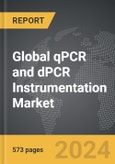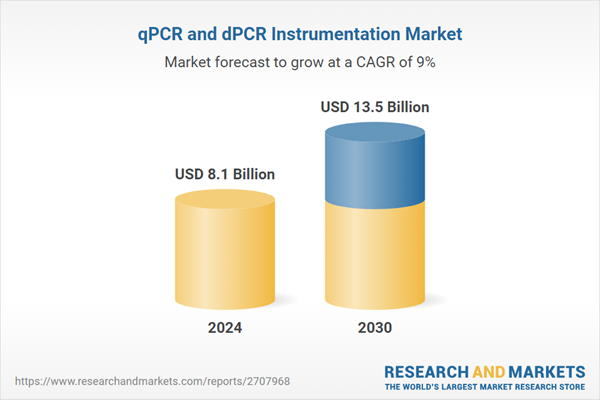Global qPCR and dPCR Instrumentation Market - Key Trends & Drivers Summarized
Quantitative PCR (qPCR) and digital PCR (dPCR) instrumentation are critical tools in molecular biology, enabling precise and accurate quantification of nucleic acids in various applications. qPCR, also known as real-time PCR, measures the accumulation of DNA during the PCR process in real-time, allowing for the quantification of specific DNA sequences. This technique is widely used in diagnostics, gene expression analysis, and pathogen detection due to its sensitivity, specificity, and ability to provide quantitative data. dPCR, on the other hand, partitions a sample into thousands of individual reactions, providing absolute quantification of DNA without the need for standard curves. This method is particularly advantageous for detecting low-abundance targets and analyzing complex mixtures, making it highly valuable in clinical diagnostics, genetic research, and environmental testing.Technological advancements have significantly enhanced the performance and capabilities of qPCR and dPCR instruments. Modern qPCR systems feature advanced thermal cyclers, highly sensitive optical detection systems, and user-friendly software that streamline data analysis. These instruments are designed for high throughput, enabling simultaneous analysis of multiple samples and reducing the time required for experiments. Additionally, the development of multiplexing capabilities allows for the detection of several targets in a single reaction, increasing the efficiency and cost-effectiveness of qPCR assays. dPCR technology has also evolved, with innovations such as microfluidic platforms and droplet-based systems that enhance partitioning accuracy and reproducibility. These advancements have expanded the applications of dPCR, enabling more precise quantification of rare mutations, copy number variations, and pathogen loads.
The growth in the qPCR and dPCR instrumentation market is driven by several factors. The increasing demand for accurate and rapid diagnostic tools in the healthcare sector is a primary driver, particularly in the wake of the COVID-19 pandemic, which underscored the need for reliable nucleic acid testing. The rise in genetic research and personalized medicine is also propelling market growth, as qPCR and dPCR are essential for gene expression analysis, mutation detection, and biomarker discovery. Technological advancements, including the development of more sensitive and high-throughput instruments, are attracting researchers and clinicians seeking to improve their analytical capabilities. Furthermore, the expansion of applications in agriculture, food safety, and environmental monitoring is boosting the adoption of these technologies. Government funding and investments in genomic research and public health initiatives are further supporting market growth. These factors, combined with continuous innovation and the integration of automated and digital solutions, are expected to drive sustained growth in the qPCR and dPCR instrumentation market in the coming years.
Report Scope
The report analyzes the qPCR and dPCR Instrumentation market, presented in terms of market value (USD). The analysis covers the key segments and geographic regions outlined below.- Segments: Classification (qPCR, dPCR); Component (Reagents & Consumables, Instruments, Software & Services); End-Use (Hospitals & Diagnostic Centers, Research Laboratories & Academic Institutes, Pharma & Biotech Companies, Clinical Research Organizations, Forensic Laboratories).
- Geographic Regions/Countries: World; USA; Canada; Japan; China; Europe; France; Germany; Italy; UK; Spain; Russia; Rest of Europe; Asia-Pacific; Australia; India; South Korea; Rest of Asia-Pacific; Latin America; Argentina; Brazil; Mexico; Rest of Latin America; Middle East; Iran; Israel; Saudi Arabia; UAE; Rest of Middle East; Africa.
Key Insights:
- Market Growth: Understand the significant growth trajectory of the qPCR Instrumentation segment, which is expected to reach US$11.3 Billion by 2030 with a CAGR of 8.4%. The dPCR Instrumentation segment is also set to grow at 11.9% CAGR over the analysis period.
- Regional Analysis: Gain insights into the U.S. market, valued at $2.5 Billion in 2024, and China, forecasted to grow at an impressive 11.6% CAGR to reach $1.2 Billion by 2030. Discover growth trends in other key regions, including Japan, Canada, Germany, and the Asia-Pacific.
Why You Should Buy This Report:
- Detailed Market Analysis: Access a thorough analysis of the Global qPCR and dPCR Instrumentation Market, covering all major geographic regions and market segments.
- Competitive Insights: Get an overview of the competitive landscape, including the market presence of major players across different geographies.
- Future Trends and Drivers: Understand the key trends and drivers shaping the future of the Global qPCR and dPCR Instrumentation Market.
- Actionable Insights: Benefit from actionable insights that can help you identify new revenue opportunities and make strategic business decisions.
Key Questions Answered:
- How is the Global qPCR and dPCR Instrumentation Market expected to evolve by 2030?
- What are the main drivers and restraints affecting the market?
- Which market segments will grow the most over the forecast period?
- How will market shares for different regions and segments change by 2030?
- Who are the leading players in the market, and what are their prospects?
Report Features:
- Comprehensive Market Data: Independent analysis of annual sales and market forecasts in US$ Million from 2024 to 2030.
- In-Depth Regional Analysis: Detailed insights into key markets, including the U.S., China, Japan, Canada, Europe, Asia-Pacific, Latin America, Middle East, and Africa.
- Company Profiles: Coverage of players such as Abbott Laboratories, Inc., Agilent Technologies, Inc., Becton, Dickinson and Company, Beckman Coulter, Inc., Bio-Rad Laboratories, Inc. and more.
- Complimentary Updates: Receive free report updates for one year to keep you informed of the latest market developments.
Some of the 74 companies featured in this qPCR and dPCR Instrumentation market report include:
- Abbott Laboratories, Inc.
- Agilent Technologies, Inc.
- Becton, Dickinson and Company
- Beckman Coulter, Inc.
- Bio-Rad Laboratories, Inc.
- bioMerieux SA
- Asuragen, Inc.
- Analytik Jena AG
- Biocartis NV
- Biotecon Diagnostics GmbH
- BioFire Diagnostics LLC
- Alifax SpA
- Anitoa Systems LLC
- AB ANALITICA s.r.l.
- Bio Molecular Systems
This edition integrates the latest global trade and economic shifts into comprehensive market analysis. Key updates include:
- Tariff and Trade Impact: Insights into global tariff negotiations across 180+ countries, with analysis of supply chain turbulence, sourcing disruptions, and geographic realignment. Special focus on 2025 as a pivotal year for trade tensions, including updated perspectives on the Trump-era tariffs.
- Adjusted Forecasts and Analytics: Revised global and regional market forecasts through 2030, incorporating tariff effects, economic uncertainty, and structural changes in globalization. Includes historical analysis from 2015 to 2023.
- Strategic Market Dynamics: Evaluation of revised market prospects, regional outlooks, and key economic indicators such as population and urbanization trends.
- Innovation & Technology Trends: Latest developments in product and process innovation, emerging technologies, and key industry drivers shaping the competitive landscape.
- Competitive Intelligence: Updated global market share estimates for 2025, competitive positioning of major players (Strong/Active/Niche/Trivial), and refined focus on leading global brands and core players.
- Expert Insight & Commentary: Strategic analysis from economists, trade experts, and domain specialists to contextualize market shifts and identify emerging opportunities.
Table of Contents
Companies Mentioned (Partial List)
A selection of companies mentioned in this report includes, but is not limited to:
- Abbott Laboratories, Inc.
- Agilent Technologies, Inc.
- Becton, Dickinson and Company
- Beckman Coulter, Inc.
- Bio-Rad Laboratories, Inc.
- bioMerieux SA
- Asuragen, Inc.
- Analytik Jena AG
- Biocartis NV
- Biotecon Diagnostics GmbH
- BioFire Diagnostics LLC
- Alifax SpA
- Anitoa Systems LLC
- AB ANALITICA s.r.l.
- Bio Molecular Systems
Table Information
| Report Attribute | Details |
|---|---|
| No. of Pages | 573 |
| Published | December 2025 |
| Forecast Period | 2024 - 2030 |
| Estimated Market Value ( USD | $ 8.1 Billion |
| Forecasted Market Value ( USD | $ 13.5 Billion |
| Compound Annual Growth Rate | 9.0% |
| Regions Covered | Global |









